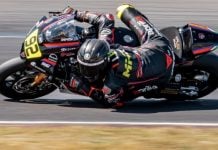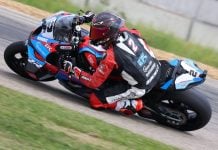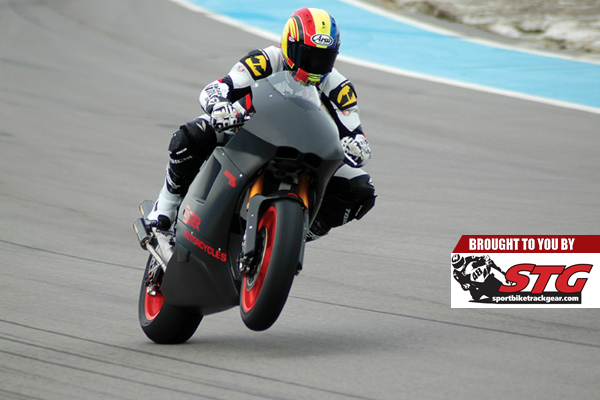- To read more articles like this one originally published in the March 2017 print issue of Roadracing World, subscribe to Roadracing World.

This featured article is brought you by Sportbike Track Gear. STG is the premier supplier for all your sportbike riding gear and performance parts. For the “do-it-yourselfers” who enjoy working on their own bike, STG has over 2,000 hard-part-install videos to help you get the best result on your next project. Family-owned and operated since 2006 with a dedicated staff of people who actually ride, working their asses off to keep yours in the saddle. No one works harder to earn your business than STG!
https://www.sportbiketrackgear.com/
Dreams Come True
By David Swarts
There are good days and then there are really good days. Any day you get to ride a motorcycle is usually a good day. Days when you get to ride a motorcycle at the racetrack are really good days. Then there are better days, like when you make a breakthrough with your riding or improve on your personal best lap time or earn a trophy after a hard-fought motorcycle road race.
Then—for some lucky few—there are the best of days. Like getting to take delivery of your ultra-exclusive dream bike, ride it around a racetrack and make your dreams come true. Executive David Frick had the best of days riding his new racebike at a private track in California, and we were there.
…
In late 2015, Suter Industries announced that it was making its own replica of the 500cc V4 two-stroke Grand Prix racebikes that were ridden by legends like Alex Criville, Mick Doohan, Wayne Gardner, Eddie Lawson, Wayne Rainey, Kenny Lee Roberts (a.k.a. Junior), Valentino Rossi and Kevin Schwantz, among others.
Although each of the men listed won a World Championship on a 500cc two-stroke racebike, they all also suffered their fair share of vicious, bone-snapping crashes in pursuit of those titles because tire and chassis technology struggled to keep pace with the ever-increasing horsepower being produced by these peaky engines. This man-versus-machine struggle elevated those who were able to ride and win on 500cc V4 Grand Prix racebikes to the status of a god in the eyes of many racing fans.

Detail of the seat foam and bike build number, 19 out of 99 planned – Photo by David Swarts.
Frick wasn’t a Grand Prix racing fan from the start. Growing up in rural Missouri, Frick enjoyed riding motocross and developed a life-long love for riding and working on two-stroke motorcycles. Later in life, Frick became a fan of Grand Prix motorcycle road racing during the twilight of the 500cc two-stroke era. He said Max Biaggi and Garry McCoy were two of his favorites. And after he was attracted to road racing, Frick took up riding motorcycles at track days, but he maintained his fondness for two-strokes.
“I’ve always been a big two-stroke enthusiast and gearhead,” said Frick. “I grew up riding two-stroke dirt bikes and then I got some 500cc two-stroke streetbikes from Canada and brought them over the border, like Yamaha RZ500s, and turned them into track-day bikes.
“Last year, I got a Yamaha TZ250, and I loved that thing. It was fast as hell and it handled so great. Then Geoff Maloney (owner of GPTech) and another buddy of mine were telling me about the Suter, and it sounded like something really cool.”
The Suter Frick referred to is the Suter MMX500, the Swiss company’s take on the 500cc V4 two-stroke Grand Prix racebikes that Doohan, Lawson, Rainey, Schwantz and the others rode. And we’re here to tell you that the MMX500 wasn’t built to just sit around looking pretty.

The Suter MMX500 without fairing, on pit lane at the Thermal Club near Palm Springs, California. The bike has Öhlins FGR300 TTX25 43 mm inverted forks with an optional FVP46 shock; OZ forged magnesium wheels; Brembo brake discs, radial-mount four-piston GP4-RR front calipers and radial front master cylinder. The aluminum twin-spar chassis can be adjusted for wheelbase, ride height, steering head angle and offset, swingarm pivot position, and riding position – Photo by David Swarts.
Suter knows what it’s doing when it comes to Grand Prix motorcycle road racing. The company has been heavily involved in motorcycle road racing since its founder, Eskil Suter, was a racer in the 250cc and 500cc World Championships in the 1990s.
Eskil Suter started Suter Racing Technology (SRT) in 1996, and in 1998 Suter was both a parts supplier and a development rider for the MuZ/Weber/Swissauto 500cc GP racebike. The following year, SRT built the chassis for that MuZ/Weber/Swissauto racing project. SRT then designed and developed the 900cc Inline Triple engine that powered Foggy Petronas streetbikes and World Superbikes. In 2004 and 2005, SRT supplied the chassis for the Kawasaki factory MotoGP racebike.
In 2010, Suter got involved in the new Moto2 World Championship and won the Manufacturer’s World Championship for three years straight. In 2012, Marc Marquez used a Suter to win the Moto2 Rider’s World Championship. Since then, Suter has worked on MotoGP Claiming Rule Team (CRT) projects and continues to supply racing components to several MotoGP, Moto2, Moto3 and Superbike teams around the world. And Suter does contract engineering work for special projects we’ll probably never know anything about.

Suter MMX500 with carbon-fiber fairing. Carbon-fiber is also used for the front fender, tank cover, inner rear fender and seat/tailsection. Note swingarm with stickers for OZ wheels, Regina chain, MecTronik electronics, and Frick’s – Photo by David Swarts.
Asked how the company went from all of that to producing its own V4 two-stroke racebike, Suter Industries CEO Maurizio Bäumle told Roadracing World, “The owner, Eskil Suter, is a real two-stroker. His partners are, too. But nobody could buy a real 500 factory bike at that time. Nobody could experience this kind of ass kick. I tell it that way. That was the inspiration from Eskil to build something so somebody could have it.”
Suter’s MMX500 is the real deal. Rather than start with something left over from the past, Suter chose to develop the new machine entirely in-house from the ground up, starting with the engine and every component in it.

Disassembled Suter MMX500 front and rear crankshafts are geared together when assembled and installed in the V4 engine – Photo Courtesy Suter.
At the end of the 500cc V4 two-stroke era, all of the Japanese manufacturers had settled on a bore and stroke of 54 mm x 54 mm. But since there is no longer a rulebook to follow, Suter decided to increase displacement to gain more torque and more accessible power. So Suter went with a bore and stroke of 56.0 mm x 58.5 mm, which equates to a displacement of 576cc for the V4 (which has its cylinder banks angled 80 degrees apart). With electronic port fuel-injection courtesy of the Italian firm MecTronik and custom single-resonance exhaust chambers from Akrapovic, the engine produces over 190 horsepower at 13,000 rpm at the output shaft. That’s on par with what the V4 500cc racebikes were producing at the end of their World Championship era.

The MMX500’s cartridge gearbox unbolts from the crankcases – Photo Courtesy Suter.
Long gone are the days of changing jets, needles and nozzles to adjust fueling on a two-stroke. Thanks to MecTronik’s closed-loop fuel-injection system and Power Tuner Tool in the engine management system, the rider can adjust fuel injector duration (up or down 15%, in 3% increments) and switch between three pre-programmed engine maps—all on the fly, via buttons on the left handlebar. Any changes can be visually confirmed on the I2M LCD dashboard, which also includes a digital tachometer, gear position indicator, shift lights, lap timer/split timer, and GPS track mapping. A 2D BigDash, a 2D data recorder, 2D lap analysis software, engine mapping software, suspension travel sensors, and brake pressure sensors are also available as options.

The Suter MMX500 V4 engine with throttle bodies in between the cylinder banks – Photo Courtesy Suter.
But that’s as far as the electronics go. There is no traction control, no wheelie control, and no launch control. But why not?
“First of all, you want to give the real impression like the hammer to the people, like it should really kick you,” said Bäumle. “And secondly, there is fuel injection but it’s not like a four-stroke. It’s very complicated to run the traction control, because how do you regulate the power? If you take back the ignition timing or cut fuel that’s not good. It’s a two-stroke. The engine seizes [because the pre-mixed oil and fuel is also the lubricant]. So it’s quite complicated on that thing.”
While the fuel-injected two-stroke engine is a mix of old and new, the MMX500 chassis is built using the latest Moto2 and MotoGP technology and is likely far better than the chassis of the 1990s. The main frame and swingarm are composed of large pieces of aluminum that are produced precisely to specification by a CNC machine and painstakingly welded together by experts. And it’s the rigidity designed into these pieces that means as much to the handling of the machine as the geometry numbers, according to Bäumle.
“This is what we learned with the experience from building the Moto2 bikes, with the experience from building the MotoGP bikes for Kawasaki, what we have learned from the CRT machines,” said Bäumle.
The chassis of the Suter MMX500 is adjustable for wheelbase, ride height, steering head angle, steering head offset, swingarm pivot position and riding position—just like a proper racebike. As-delivered, the machine is set to a wheelbase of 57.0 inches (1450 mm), rake is 24.5 degrees and trail is 4.07 inches (103.5 mm), which are numbers Suter engineers confirmed during a testing program.

A fabricator works on the aluminum frame – Photo Courtesy Suter.
Suspension components are one of the few options for owners to choose from. Frick opted for the standard, fully-adjustable Öhlins FGR300 TTX25 43mm inverted forks and upgraded from the standard Öhlins TTX36 to an Öhlins RVP46 2016-spec shock. And as you would expect from a chassis company like Suter, different shock linkages are also available.
The standard brake system includes dual 320 mm (12.6-inch) x 6.0 mm Brembo full-floating stainless steel discs, radial-mount Brembo GP4-RR 32/36 four-piston calipers and a radial Brembo 19/18 master cylinder in the front, with a single 218 mm (8.6-inch) x 4.0 mm Brembo disc, a Brembo P4.24 caliper and a 13mm Brembo master cylinder with integrated reservoir in the rear. Brembo T-drive discs, carbon discs and pads, and lightweight calipers with titanium pistons are available as options.
Forged aluminum OZ wheels—a 3.75 x 17.0-inch front and 6.00 x 17.0-inch rear—come standard, but forged magnesium OZ wheels like those on Frick’s machine are a “small” upgrade, according to Bäumle. And SRT Penta carbon-fiber wheels will be available soon. Any of those wheels can come wearing whatever tires the owner chooses. Frick chose Pirelli slicks, a 120/70-R17 front and a 200/60-R17 rear, both in the SC2 compound. Bäumle said the MMX500 will work with any brand of racing tires, but it was developed on Dunlops—a 120/70-R17 front and a 195/65-R17 rear—as used in Moto2.
The machine is finished off with a set of tight-fitting, aerodynamic carbon-fiber bodywork, including a carbon-fiber fuel tank and a self-supporting carbon-fiber tailsection/seat unit. Suter claims the MMX500 weighs just 279 pounds (127 kg) dry.
So that’s 190 horsepower, 279 pounds and 99 numbered units that will ever be built. Starting price is 128,000 Swiss Francs, which was just over $127,000 U.S. at mid-January exchange rates.
…

Dave Frick aboard his new Suter MMX500 after taking delivery at The Thermal Club – Photo by David Swarts.
After flying to Switzerland and visiting Suter in person for a close-up look and some due diligence before making this significant investment, Frick put down his initial deposit and ordered his bike, #19, in October of 2016. Frick had expected his MMX500 to be delivered in the spring, in time for the start of the track day season back in the Midwest. But when Maloney (who had been assisting Suter with service and support through his company, GPTech) told Frick he could pick up his bike early, Frick immediately hopped on a plane to California.
Frick met up with Maloney, Bäumle and the MMX500 at The Thermal Club, a private car racetrack near Palm Springs, California, where Maloney is a member. With Frick’s permission, Maloney (himself a long-time racer, race team owner and the owner of a Honda NSR500V Grand Prix racebike he rides for fun), invited Roadracing World Racing Editor Chris Ulrich (a former racer who finished third on a TZ250 two-stroke in the 1999 AMA 250cc Grand Prix Championship) out to ride the incredible machine.

New Suter MMX500 owner Dave Frick (center, left) poses with Chris Ulrich (center, right), Suter CEO Maurizio Bäumle (left), Frick’s friend Dan Sokolich (second from left) and GPTech’s Geoff Maloney (right). The 576cc fuel-injected two-stroke V4 Suter makes about 190 horsepower and weighs about 279 pounds dry. Photo by David Swarts.
Rather than sit back and expect to be waited on, Frick immediately plugged the total-loss ignition system’s battery into a charger, started putting warmers on his new bike’s tires and later set his own tire pressures. And when it came time to start the MMX500, Frick turned down the offer of using starting rollers or even accepting a push. Frick clicked the Suter into second gear, turned on the power switch, pushed the machine down pit lane, jumped on side-saddle and bump-started the bike like he was heading out to ride with King Kenny Roberts and Barry Sheene.
Although he has never competed in a single motorcycle road race, Frick quickly established himself as someone who knows how to ride a motorcycle. With each lap of the short but flowing North Course at The Thermal Club, Frick increased his momentum through the corners and opened the throttle earlier and earlier coming out of the slow final turn. Before long, the front tire of the Suter was regularly coming off the pavement as Frick exited the final corner and powered down the pit straight.
After Frick rode an initial handful of laps, he handed his brand new bike over to Ulrich, who had been learning the track on a Suzuki GSX-R1000 racebike while Frick was riding the Suter. Ulrich rode the MMX500 for a session lasting several laps around the unfamiliar course, before coming in and returning the Suter to its owner. Frick and Ulrich then alternated riding the MMX500 throughout the day. Each time he rode, Ulrich provided feedback and suggestions to help improve the chassis set-up of the machine even though he admitted to being in awe of the Suter.
“I was excited just to see the thing, to be that close to a prototype motorcycle after spending so much time on production streetbikes that were turned into racebikes,” said Ulrich, unable to restrain his enthusiasm despite his years of testing motorcycles and racebikes all around the world. “It’s been 17 years since I’ve been on a two-stroke TZ250. I was excited just to be around it and hear the exhaust and smell the pre-mix. It’s like a childhood dream. You watch Kevin Schwantz and Wayne Rainey go at it your whole life, and the next thing you know you’re sitting on top of a 500.
“First of all, it’s a really good-looking bike. I could admire it for a long time. The bike is very short, but the swingarm is huge, so long. The tailsection is carbon-fiber and self-supporting. The dry slipper clutch. All of it screams quality and it screams money.
“One thing I had to adjust to, I actually had to put the gas on and slip the clutch to move the thing. On a four-stroke you just let the clutch out and go. On this, I had to give it some rpm and slip the clutch to go. I actually stalled it once coming out of the pits. But bump starting it was fun. I haven’t done that in so long. It’s like taking a step back but in a really good way.
“I’m six-foot-tall, and there’s not very much room on the Suter. The seating position is really far forward, and the attitude of the bike is forward. And they set it up that way to get the most weight on the front to keep the front wheel on the ground.
“There were a couple of things I was nervous about before I got on the bike. One was power delivery and the other was the lack of engine braking. When you have a lack of engine braking you end up riding the front tire quite a bit to go fast, but I’m used to trailing the brakes all the way to the apex so it wasn’t that big of a deal.

Chris Ulrich was third in the 1999 AMA 250cc Grand Prix Championship on a TZ250, so riding the Suter MMX500 was a two-stroke homecoming. Photo by ted7.com.
“My first few laps when the power hit coming down the straightaway, it wasn’t the wheelie machine like I thought it was going to be. That’s because of the way they have the geometry set up and because it was running a little bit rich. It was gnarly, but it wasn’t that gnarly. I think that’s because when the power came on at 8,000 rpm it would progressively pick up and go. Even when I leaned the bike out, it wasn’t super aggressive. So from that standpoint it was pretty easy to ride.
“Physically, to turn the bike left to right, it was very easy. The last five or six laps I got to do I was riding pretty hard, and the amount of physical effort it took to flick it into a turn was nothing. It’s not a 1000 with a long, heavy crankshaft. My superbike was 375 pounds without fuel, and this thing is 279 pounds without fuel. So it doesn’t take a lot of effort to make the thing go from straight up to down on its side or to flick it left to right. You can just go boom, boom, boom.

Despite the Suter MMX500 not having advanced electronic traction control, wheelie control, and launch control, Roadracing World’s Chris Ulrich found it to be controllable and rideable thanks to a modern chassis, suspension and tires, along with smooth, well-mapped fuel injection. Photo by Ted7.com.
“You can also stop it pretty quickly, but I was hesitant. I was already sitting on the nose and the front end was diving pretty quickly through the stroke and getting into that part of the fork where I was sitting just on the oil. You can do that a couple [or] three times to see where you’re at, but then you need to dial it back to make sure you can make the corner and don’t go flipping some guy’s $127,000 bike down the road. Overall, the braking performance was good and it stopped pretty quickly, but the stopping distance was hindered by the fact that we needed to adjust the chassis and change the fork settings, more than any characteristic of the bike.
“The bikes I ride these days they’re all 1000s, they’re all 600s, they’re all four-strokes. I go ride them to their limit, and I usually get to the bike’s limit before I get to my limit. This thing, there’s probably a lot more in it. (laughs) It was bitchin’!
“I didn’t find the limit. I spun it up, left some black marks, did some wheelies, had a lot of fun, but I didn’t get to its limit. I would need to change a bunch of stuff to get to its limit, and the best part is you can do it with this bike because it’s a proper racebike. But this one is Dave’s bike.”

Racing Editor Chris Ulrich leans the 190-horsepower, $127,000 Suter MMX500 576cc V4 into a corner at The Thermal Club. Expansion chambers for the front two cylinders exit on the bike’s right, with expansion chambers for the rear two cylinders mounted under the self-supporting carbon-fiber seat/tailsection – Photo by ted7.com.
Normally, we’re all about numbers at Roadracing World, especially when it comes to recording lap times. However, considering we had never been on The Thermal Club’s North Course before and had no frame of reference, lap times were irrelevant. But if your unit of measure is smiles per hour, the Suter MMX500 was a huge success.
“I was pretty excited before riding the Suter, and I was buzzing afterward,” said Ulrich. “I was giddy driving home and telling my dad how cool it was. Then I was at home at 9:30 or 10:00 at night and my wife asked me if I was going to sleep anytime soon. I told her, ‘No, I’m still buzzing. I’m still riding that wave.’ She said, ‘I don’t understand. It’s just another motorcycle.’‘Noooo! This was a 500. It’s one of those deals you dream about as a kid.’

Arch Motorcycles’ Keanu Reeves talks motorcycles with Roadracing World’s Chris Ulrich during the test at Thermal. Arch Motorcycles is now importing the Suter MMX500 motorcycle. Photo by David Swarts.
“The big thing was it did not disappoint. It was still hard to ride. It was fast and everything you would expect, except it was the modern version of it. The power delivery was smooth. The fuel injection, once we leaned it out, was smooth. The chassis was more than up to the task. The brakes were good. The tires were good. All these modern things packaged together made the bike a lot easier to ride than I imagine one of the 500s back in the day were to ride.
“Suter did a great job with the MMX500, two-strokes are and will always be bad-ass. Dave Frick is one lucky guy, and dreams can come true.”
To read more articles like this March 2017 test ride please subscribe to Roadracing World.






